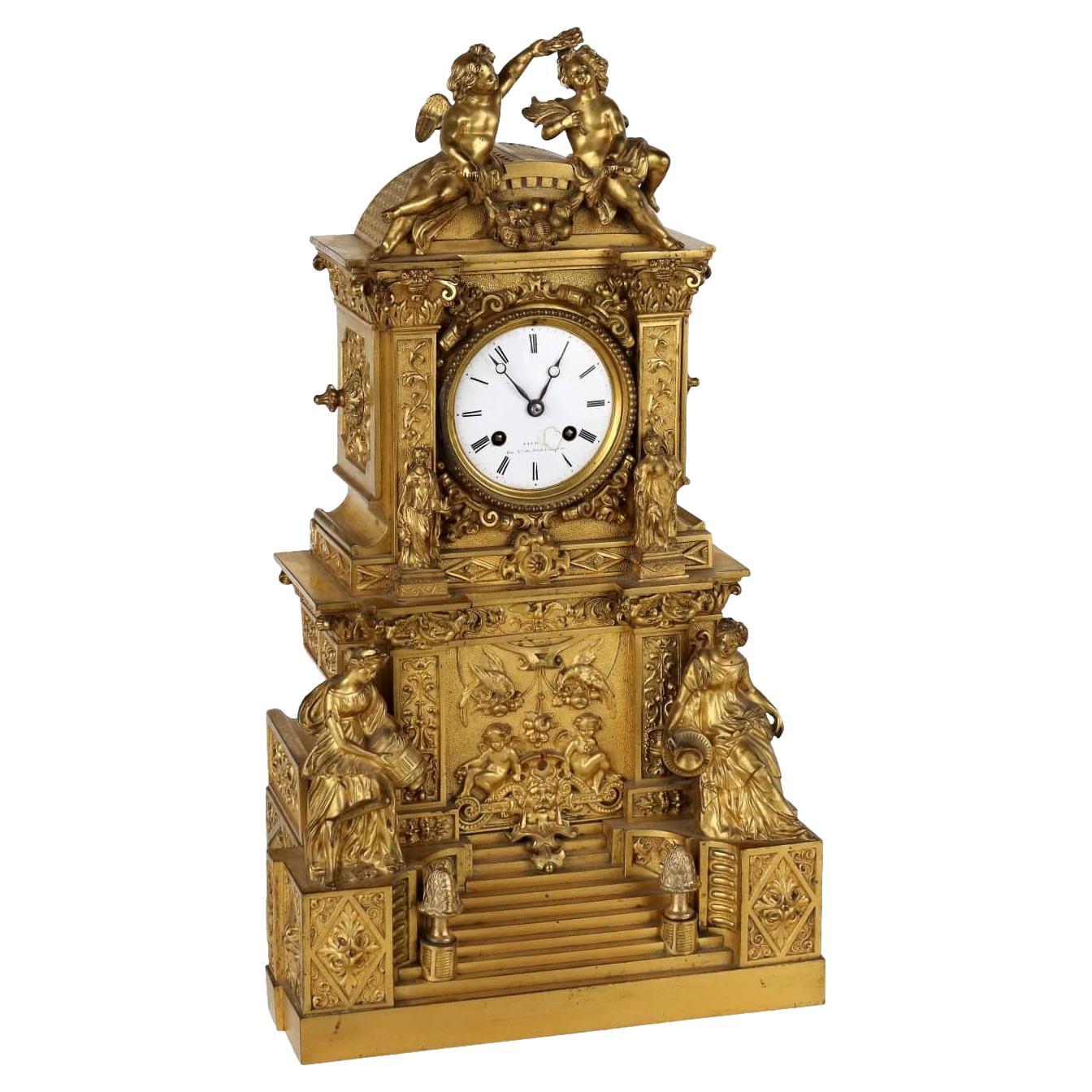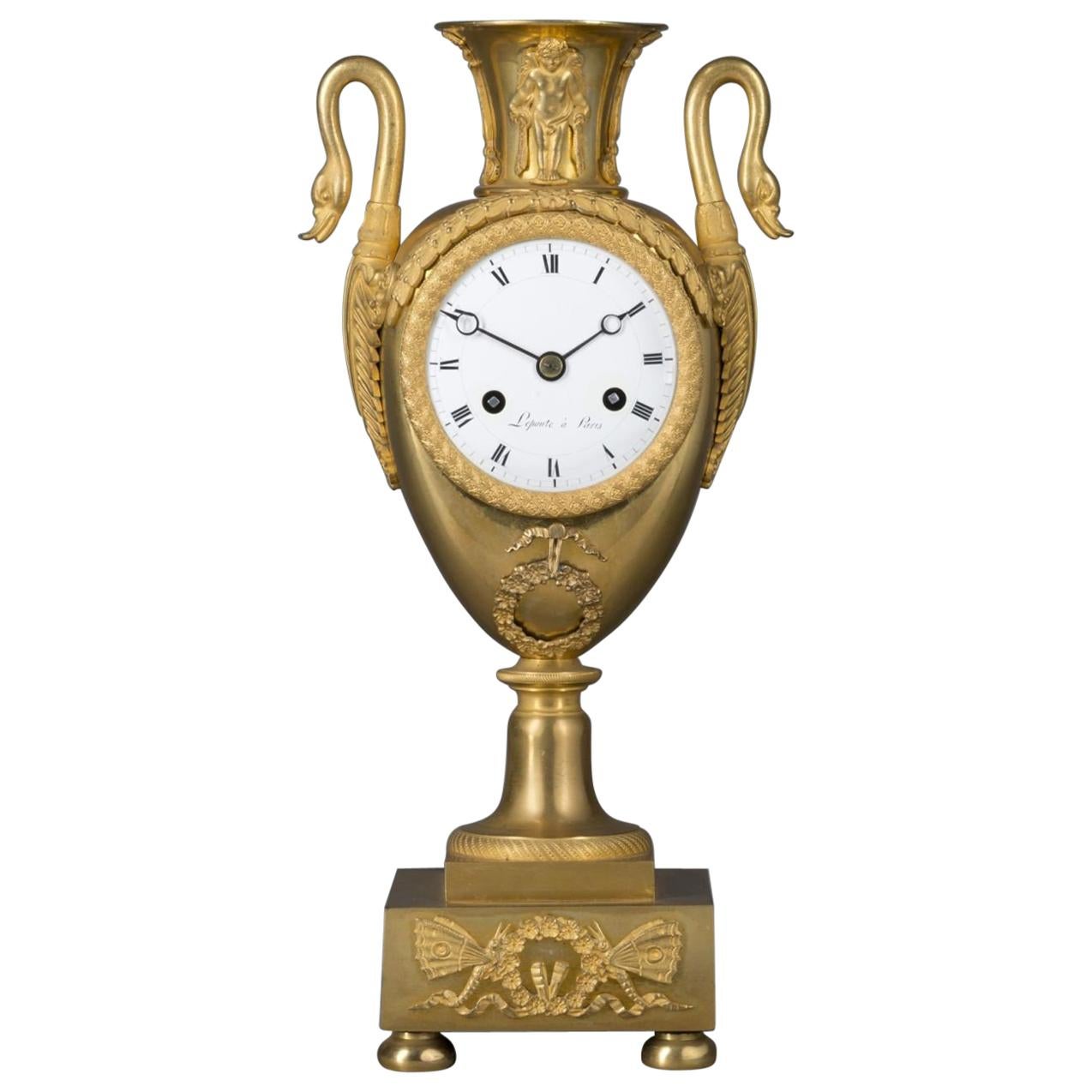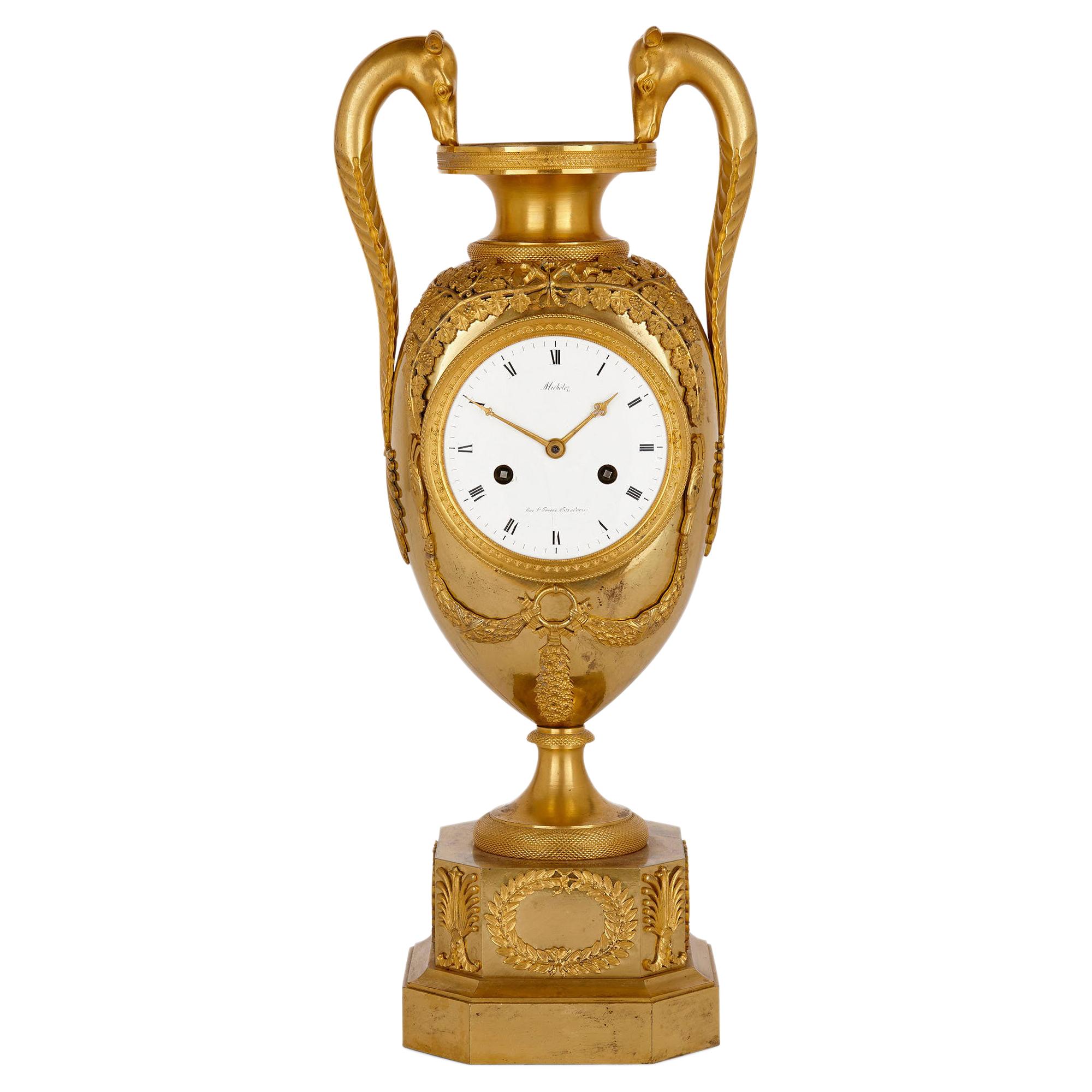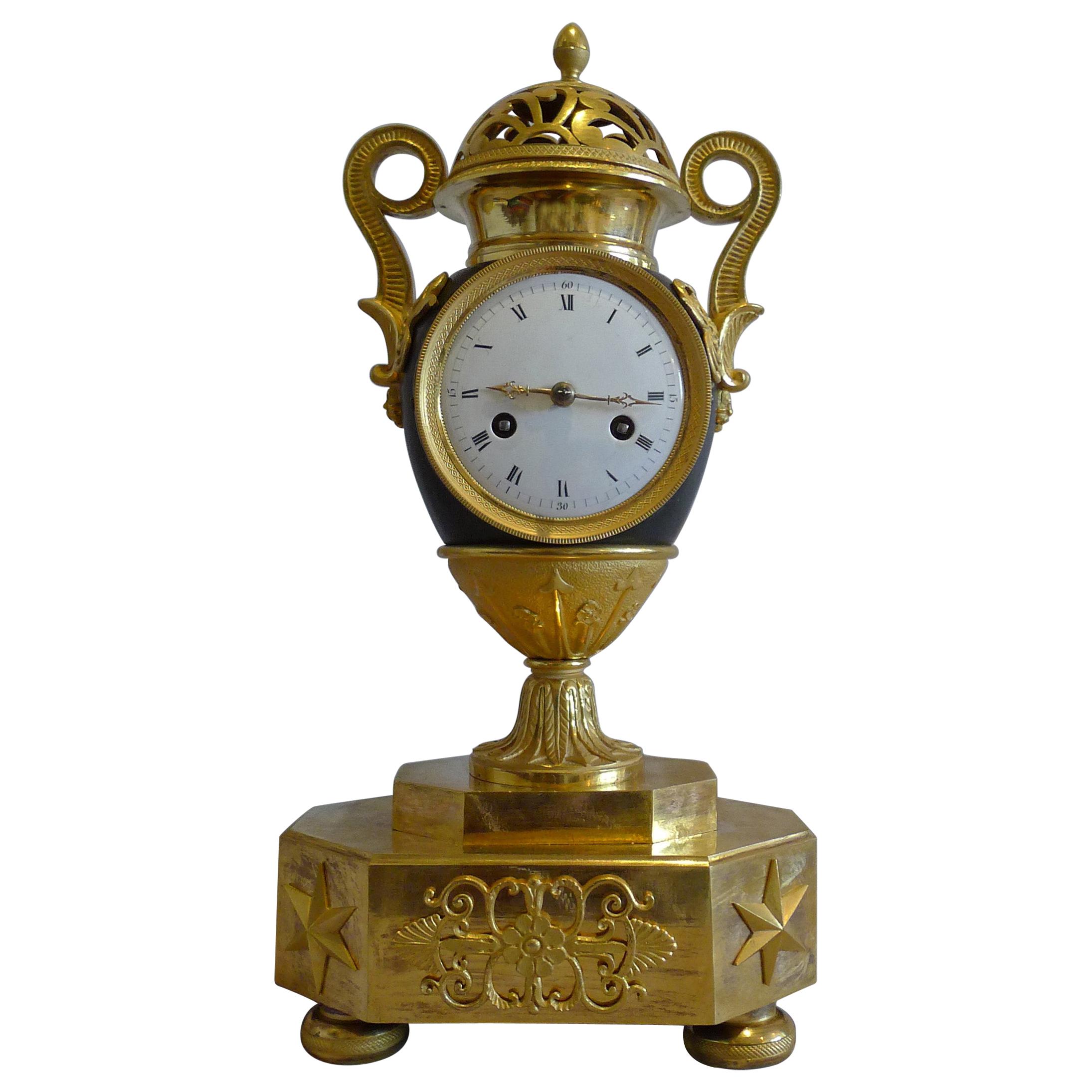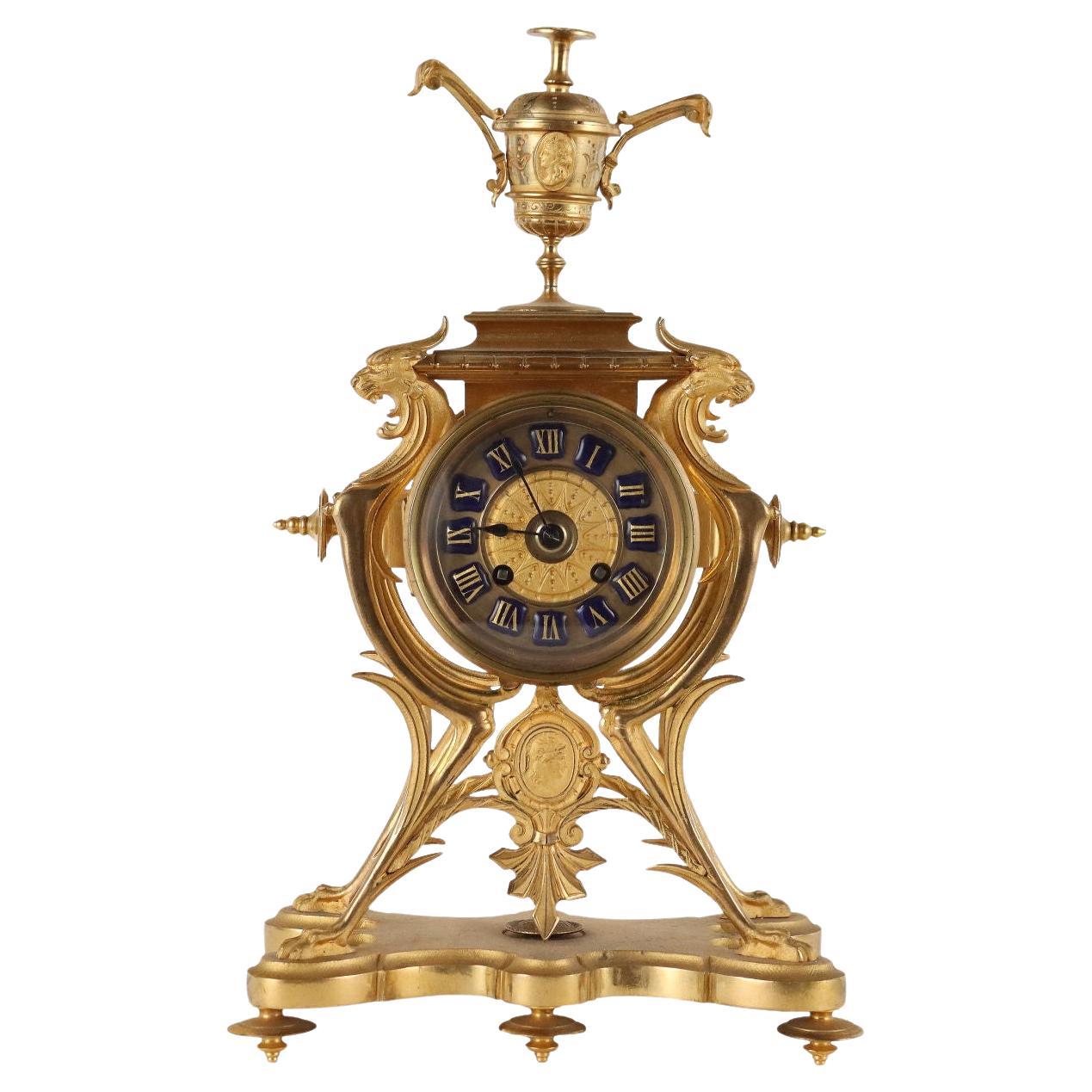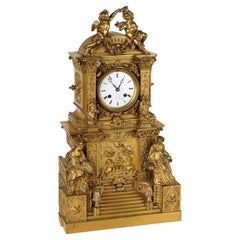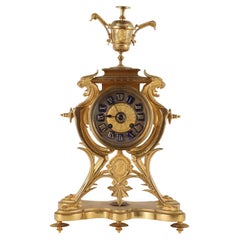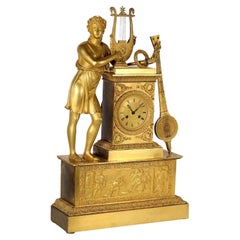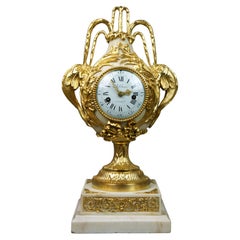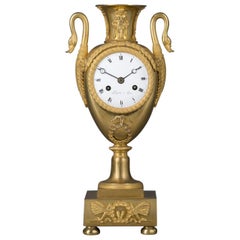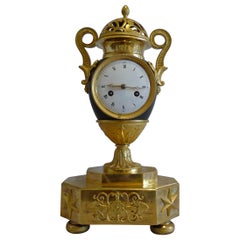Items Similar to Orologio a Vaso Francia Primo Quarto XIX Secolo
Want more images or videos?
Request additional images or videos from the seller
1 of 9
Orologio a Vaso Francia Primo Quarto XIX Secolo
$10,048.75
£7,657.17
€8,500
CA$14,076.22
A$15,325.69
CHF 8,024.33
MX$183,959.07
NOK 101,271.79
SEK 94,959.52
DKK 64,744.44
About the Item
Orologio a vaso in bronzo dorato poggiante su un plinto ornato con motivi a foglie susseguenti poggiante su quattro piedini a sfera. Il corpo dalla caratteristica forma a vaso biansato è ornata con applicazioni in bronzo finemente cesellato e dorato: nella parte inferiore un volto di medusa alata è affiancata da antemi, mentre in quella superiore è appoggiata una panoplia, sul collo presente testa con ali da farfalla; le due prese sono tenute da due mascheroni e terminano a ricciolo sul collo del vaso. Mostra smaltata di bianco con numeri romani.
Espressione del gusto impero, sia nella forma che nei motivi ornamentali, l’orologio rientra nella ricca ed eterogenea produzione di orologi francese, che ebbe larga diffusione proprio nel primo quarto del XIX secolo.
I modelli a vaso erano alquanto diffusi: un esempio è dato dal catalogo degli orologi conservati presso il Mobilier National, dove ne compare uno simile, in particolare nelle anse terminanti a rosoni.
- Dimensions:Height: 13.71 in (34.8 cm)Width: 7.88 in (20 cm)Depth: 4.53 in (11.5 cm)
- Style:Empire (Of the Period)
- Materials and Techniques:
- Place of Origin:
- Period:
- Date of Manufacture:1800s
- Condition:Wear consistent with age and use.
- Seller Location:Milano, IT
- Reference Number:1stDibs: LU1721239225942
About the Seller
4.9
Platinum Seller
Premium sellers with a 4.7+ rating and 24-hour response times
Established in 2015
1stDibs seller since 2015
437 sales on 1stDibs
Typical response time: 1 hour
- ShippingRetrieving quote...Shipping from: Milan, Italy
- Return Policy
More From This Seller
View AllOrologio da Appoggio in Bronzo Dorato, Francia Metà XIX Secolo
By Non-Standard Furniture and Lighting
Located in Milano, IT
Orologio in bronzo dorato e cesellato. La complessa decorazione di questo orologio sull'apparente eclettismo dell'insieme fa prevalere tipologie strutturali e dettagli figurativi tip...
Category
Antique Mid-19th Century French Other Mantel Clocks
Materials
Bronze
Gilded Bronze France Third Quarter Nineteenth Century Standing Clock
By Non-Standard Furniture and Lighting
Located in Milano, IT
Gilt bronze standing clock. The clock with bronze display and Roman numeral hours in blue enameled metal is held by four fantastic animals resting on shaped base. Under the clock med...
Category
Antique 19th Century French Other Table Clocks and Desk Clocks
Materials
Bronze
Robert & Courvoisier Gilded Bronze Table Clock France Early 19th Cent
By Non-Standard Furniture and Lighting
Located in Milano, IT
Robert & Courvoisier gilt bronze temple table clock, finely chiseled and engraved. Decorations with lion heads, winged dragons, and plant motifs. The enameled metal display with Arab...
Category
Antique 1830s French Other Table Clocks and Desk Clocks
Materials
Bronze
Table Clock in Gilded Bronze, France, First Half of the 19th Century
Located in Milano, IT
Gilded and chiseled bronze clock. On the large rectangular base there is a scene with mythological divinities in relief on a finely chiseled background. Decorations with plant motifs...
Category
Antique Early 19th Century French Other Table Clocks and Desk Clocks
Materials
Bronze
Trittico con Orologio e Coppia di Candelabri, Etienne Lenoir Henry Dasson attrib
By Henry Dasson
Located in Milano, IT
Il trittico in bronzo è costituito da un orologio centrale e da due candelabri laterali. Tutti e tre gli elementi hanno un basamento simile: sopra una base quadrata è poggiato un pli...
Category
Antique Late 19th Century French Other Table Clocks and Desk Clocks
Materials
Bronze
Tripod Vase Holder Paris Last Quarter 19th Century
By Non-Standard Furniture and Lighting
Located in Milano, IT
Tripod vase holder made of gilt bronze and Sèvres ceramics, based on a model by Pierre Gouthière. Circular base of cobalt blue Sèvres porcelain, with gilded decorations on the top an...
Category
Antique 1870s French Other Planters and Jardinieres
Materials
Bronze
You May Also Like
Louis XVI Clock in Gilt Bronze and Marble "Philibert à Paris" 18th century
Located in Pistoia, IT
Exceptional late 18th-century Louis XVI period mantel clock, modeled by court bronze worker Brécourt in collaboration with Parisian watchmaker Antoine-Marie Philibert.
The first mo...
Category
Antique Late 18th Century French Louis XVI Mantel Clocks
Materials
Marble, Bronze
Empire Clock in the Form of a Classical Urn, by Maison Lepautre, circa 1825
By Pierre-Basile Lepaute
Located in Brighton, West Sussex
A gilt bronze Empire clock in the form of a classical urn, by Maison Lepautre.
French, circa 1825.
The dial signed 'Lepaute a Paris'.
The clock has an ornate cast bezel with a 3-inch porcelain dial with Roman numerals and Breguet style hands. The twin train eight-day movement with outside count wheel striking on a bell and silk thread suspension.
This elegant Empire style clock has a gilt bronze case in the form of a classical urn with swan neck handles and a winged cherub to the neck. The circular pedestal base is raised on a footed stepped square plinth.
The Lepaute family were the premier French clockmakers of their day. Their significance lies in their contribution to the clock making industry which had hitherto come under the trade of locksmiths. The family held the brevet Horlogers du Roi.
Jean-André Lepaute (1720–1789) arrived in Paris at an early age and in 1740 founded the family business. A skilled artist and mechanic, he quickly gained an excellent reputation. He was received as maître by the clockmakers guild in 1759, was granted royal lodgings from the king in The Luxembourg Palace, and was entrusted with the construction of the majority of the great public clocks of Paris. He executed, amongst others, those in The Luxembourg Palace, the Jardin des Plantes, the Château de Bellevue and the Château des Ternes. His clock at Paris’s École Militaire still works today. Three editions of his Traité d’Horlogerie were published in Paris in 1755, 1760 and 1767. A small volume, Description de Plusieurs Ouvrages d’Horlogerie appeared in 1764. Jean-André’s wife, Nicole-Reine Etable de la Brière (1723-1788), was a highly esteemed mathematician and astronomer. Her passion for science lent itself to Lepaute’s work and she played an active role in the scientific and mathematical aspects of the clock making.
Jean-André’s younger brother Jean-Baptiste Lepaute (1727-1802) joined him in Paris in 1747 and immediately started working for the family business. He was received as maître in 1776 and was known for the clocks he constructed for the Paris Hôtel de Ville (1780), destroyed in a fire of 1871, and for the Hôtel des Invalides (1784). Jean-Baptiste took over the workshop when Jean-André retired in 1775.
After Jean-Baptiste’s death in 1802, the firm was taken over by his nephew Pierre-Basil Lepaute (1750-1843) where he was duly joined by his own nephew Jean-Joseph (1768-1846) and son Pierre-Michel (1785-1849). By 1816, Pierre-Michel Lepaute was in charge of the business. His masterpieces include the astronomical clock in Paris’s Bureau...
Category
Antique Early 19th Century French Empire Mantel Clocks
Materials
Bronze
French Empire Period Ormolu Mantel Clock by Michelez
Located in London, GB
French Empire period ormolu mantel clock by Michelez
French, circa 1815
Measures: Height 47cm, width 20cm, depth 15cm
This beautifully formed and crafted mantel clock, dating to...
Category
Antique Early 19th Century French Empire Mantel Clocks
Materials
Ormolu, Bronze
$7,027 Sale Price
30% Off
French Empire Patinated Bronze and Ormolu Vase Clock
Located in London, GB
French Empire patinated bronze and ormolu vase clock. Of unusual design set as it is on a spread ormolu base of eight sides, the front and back being long sides. The base sits upon f...
Category
Antique 1810s French Empire Mantel Clocks
Materials
Bronze, Ormolu
French Empire Allegorical Clock of Love Nourishing Life
Located in Vancouver, British Columbia
A figural French Empire clock in gilded bronze representing an allegory on how love nourishes life or “L’Amour alimentant la vie” in French. The clock shows a seated winged Amor refi...
Category
Antique Early 19th Century French Empire Mantel Clocks
Materials
Bronze
19th Century French Empire Clock
Located in Los Angeles, CA
19th Century finely chased and cast dore bronze mantle clock. Porcelain dial in excellent condition. Signed "Millet." Original pendulum. Don't have original key, but can have one made.
Category
Antique 19th Century French Empire Mantel Clocks
Materials
Marble, Bronze
More Ways To Browse
Mobilier National
Antique Medusa
Cherub Cloud
Bronze Dore Clock
Used Furniture Westminster
Gilt Bronze Relief
Medaille Bronze
Cupid Clocks
French Malachite Clocks
Rouge Marble Clock
Antique German Mantel Clocks
French Onyx Clocks
Japy Freres Antique Clocks
Monumental Clock
Antique Clock Columns
Antique Fireplace Clock
Arabic Brass
Column Clock
